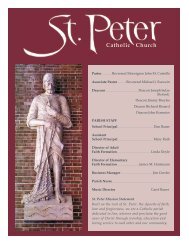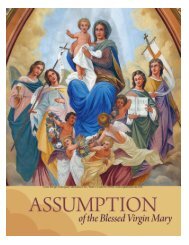St. Peter Catholic Church
St. Peter Catholic Church
St. Peter Catholic Church
You also want an ePaper? Increase the reach of your titles
YUMPU automatically turns print PDFs into web optimized ePapers that Google loves.
Thirty-second Sunday in Ordinary Time November 6, 2011<br />
Praying the Mass Anew…<br />
Body Language: The Connection of Words and Actions at<br />
Mass<br />
To fully understand the nature of <strong>Catholic</strong> worship in the liturgy,<br />
we must always be mindful of one extremely important truth:<br />
Liturgy involves our whole being. In other words, true worship of<br />
God will not only be in mind and heart, nor only in words. Rather,<br />
true worship involves our whole person – body and soul. Hence, it<br />
is only proper that in our continuing overview of the new translation<br />
of the words for Mass, we ought to consider our actions with our<br />
bodies, and how these work together in the liturgy of the <strong>Church</strong>.<br />
The words of John 1:14 once more can serve us well: “And the<br />
Word became flesh, and made his dwelling among us.” These<br />
words of truth express how God, who “pure spirit,” wills to take on<br />
our human nature. In this topic of how our bodies are involved in<br />
worship, what can be taken from the truth of God becoming flesh<br />
(which is a mystery of faith that is referred to as the “Incarnation”)<br />
is that our bodies are integral to who we are. Hence, to worship<br />
God fully truly requires our whole being – body and soul. In fact, if<br />
we do not acknowledge the necessity of our bodies worshiping God<br />
fully, none of the sacraments of the <strong>Church</strong> would have any<br />
meaning, as the sacraments use material realities (bread and wine,<br />
for example) to communicate and offer us spiritual gifts or graces –<br />
the divine life of God.<br />
Certainly all are clearly aware that the celebration of Mass contains<br />
times of standing, sitting, and kneeling. These actions are not by<br />
chance. Each action or gesture seeks to place us in a proper frame<br />
of mind and heart to encounter God‟s presence. For example,<br />
during the times we stand, we use our bodies to help keep our<br />
minds attentive to the sung or spoken words of prayer or Sacred<br />
Scripture. When we are to kneel, we invite ourselves to become<br />
humble of heart, making ready to receive the Lord‟s Real Presence<br />
in the Eucharist. Sitting, for its part, offers us a way of making our<br />
bodies comfortable, that we might listen and meditate with greater<br />
ease. Each of these postures, taken alone, has a depth of purpose.<br />
When understood in connection with each other and within the<br />
whole Mass, they can facilitate our entrance into an encountering of<br />
God with all our being.<br />
Where do the words of the prayers fit into this praying with our<br />
bodies? Consider those prayers that are prayed at given moments.<br />
We stand for the beginning of Mass, uniting ourselves and our<br />
intentions with all who are present (and with the whole <strong>Church</strong>).<br />
We kneel during those most sacred of words, spoken first by Jesus<br />
himself at the Last Supper, through which bread and wine become<br />
his own sacred flesh and blood. In these, or any of the parts of<br />
Mass, we will find that the outward action fits the importance or the<br />
intentions of the words, so that our bodies help our minds and<br />
hearts to receive what we hear, and to express what we say.<br />
Similarly, the gesture of “bowing” is frequent at Mass, as another<br />
way of showing reverence. Truly, all are to make “a bow of the<br />
head” not only before receiving Jesus in the Eucharist, but for each<br />
and every speaking of the holy names of Jesus and Mary, and on the<br />
feasts of saints, the name of the given saint – once more connecting<br />
our bodies to the spoken word. In addition, all are to make a<br />
“profound bow,” that is, a bow “ from the waist” in praying the<br />
words of the Creed that refer to the mystery of the Incarnation (And<br />
the Word became Man). In the new translation, these words are:<br />
and by the Holy Spirit was incarnate of the Virgin Mary, and<br />
became man.” In this way, we do not simply say the words, but our<br />
whole being, body and soul, word and action, takes part in our<br />
worship of God.<br />
3<br />
In our continuing exploration of the new translation, might we all<br />
keep in mind these truths: that liturgical prayer is not only in words –<br />
but it involves our whole being as well. Our bodies truly do help us<br />
to worship God properly, opening us up to a deeper encounter with<br />
the Word, “who give his flesh for the life of the world.”<br />
Questions of the Week:<br />
What is the point of bowing and genuflecting?<br />
While both acts of bowing and genuflecting as signs of reverence and<br />
adoration signify how God in heaven came down to earth, and<br />
literally touched earth by taking on our human nature, genuflecting is<br />
more properly an act of adoration. A bow (of which there is a deep<br />
bow from the waist called the “profound bow” and the lesser “bow of<br />
the head”) causes us to lower our bodies toward the ground, mindful<br />
of Jesus who became “lower than the angels “ (Hebrews 2:9). By<br />
genuflecting, or in touching our right knee to the ground, while we<br />
once more acknowledge God‟s loving act of taking on our human<br />
nature (literally touching the earth), we more properly give adoration<br />
to Jesus, who is our Savior and at whose name “every knee shall<br />
bend”(Philippians 2:10). Genuflecting is thus used in adoration of the<br />
Eucharist, both on the altar and when reserved in the tabernacle, as an<br />
act of adoration toward our Savior and true King, present in the<br />
Eucharist.<br />
What about standing, sitting, and kneeling?<br />
These postures have varied purposes and histories. <strong>St</strong>anding is a<br />
posture of attentiveness and respect, while kneeling can convey either<br />
a disposition of humility and adoration, or of penance (or both<br />
together). We sit during times of meditative listening, or moments of<br />
silent, private prayer.<br />
Through the Middle Ages, and even to this day in parts of Europe,<br />
church buildings rarely were built with pews – hence, standing for<br />
the whole Mass was/is the normal posture. Sitting has only become<br />
an accepted posture because of the presence of pews. Kneeling, as<br />
witnessed by the custom of recent centuries of having the people<br />
kneel to receive Holy Communion, has entered into the Mass<br />
according to further invitation to express adoration and humble<br />
receptivity in approaching and partaking of the Eucharist.<br />
Today, we stand for such parts of Mass as the Introductory Rites, the<br />
Gospel, the Creed and Prayers of the Faithful, the Lord‟s Prayer, and<br />
the Concluding Rites as an expression of reverence and attentiveness<br />
to the spoken words and responses. Kneeling is reserved for times<br />
that are distinguished by the call for adoration (the Eucharistic Prayer<br />
and during Holy Communion), while sitting is used during the<br />
readings, the homily, and preparation of the gifts, as these are<br />
moments of meditation and listening.<br />
Your Attention Please!!!!<br />
There is a little old lady (she blends in beautifully) on the loose in<br />
our church who is depositing derogatory newspaper clippings<br />
against the <strong>Church</strong> and the priesthood in our missalettes and<br />
bulletins. She usually strikes before Mass begins (usually one of<br />
the Sunday morning Masses) and during the entrance rites of the<br />
Mass. You will notice her wandering from pew to pew or section<br />
by section of our church depositing her vile trash. If you see,<br />
literally, the proverbial “little old lady” sticking well placed and<br />
carefully prepared newspaper clippings in any part of the<br />
church or in any book, crevice, doorway, bulletin board of our<br />
church please contact an usher immediately. We are trying to<br />
stop the dissemination of this blasphemous bilge and gross<br />
garbage from our church. It is disturbing literature for people of<br />
prayer and it is trespassing upon sacred ground.<br />
Msgr. Jack<br />
1-3-5
















